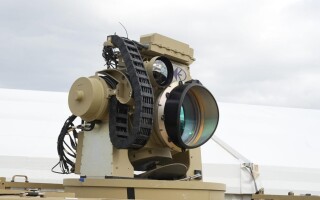How innovative technologies and a layered approach can make C-UAS solutions more effective
StoryMarch 17, 2023

The lower cost of conducting ISR [intelligence, surveillance, and reconnaissance] and attack operations with uncrewed aerial systems (UASs) has been changing the warfare scenario. Cutting-edge technologies and advanced ammunition in a layered approach can provide more effective means to detect, track, classify, and engage this type of aerial target.
Facing uncrewed aerial threats has been a concern for the U.S. Department of Defense (DoD), so its branches and agencies currently conduct several acquisition and development programs in the area. In fiscal year 2023, the DoD has allocated nearly $750 million for the procurement of solutions and counterdrone research and development.
There remains plenty of potential for growth in the domain of counter unmanned aerial systems (C-UASs).
It remains, for instance, difficult to locate, identify, and disrupt Class I (small) and Class II (medium) UASs due to their size, relatively quiet and quick maneuverability, and almost nonexistent heat and noise signatures. The ability to swarm multiple UASs also adds to the difficulty of countering the overall aerial unmanned threat. (Figure 1.)

[Figure 1 | The reduced size of Class I and II unmanned aerial systems makes them harder to be detected and located. Soldiers from the 5th Armored Brigade, First Army Division West, test the capabilities of small off-the-shelf unmanned aerial surveillance vehicles at McGregor Range Complex in New Mexico. U.S. Army photo by Staff Sgt. Timothy Gray.]
Reduced-size UASs are small enough to elude detection by standard early-warning sensor systems, explains Rob Menti, air defense strategy, Northrop Grumman (Falls Church, Virginia). “Group I and II unmanned aerial systems may not have the range or payload capacity of larger, advanced systems, but they can impact operations at the tactical level in very serious ways.”
Ryan Hurt, chief revenue officer for Liteye Systems (Centennial, Colorado), points out that the industry has been focusing on solving issues related to detection and classification such as combining different active and passive systems to operate as a single system, getting higher-fidelity detection capability by using multiple sensors, and automatically identifying targets with high confidence.
Another area with opportunities for upgrades comprises the widespread use of machine learning (ML) and artificial intelligence (AI) software. It can provide a better classification of the objects that have been detected and high-fidelity tracking of where targets are.
Hurt notes that identification friend or foe (IFF) technologies have been using the AI/ML approach to identify adversaries, adding that “we are going to see a lot of it in the future in the area of improvement around AI software classification.”
From Menti’s perspective, ML and AI help reduce the cognitive load on the operator and quickly closes the kill chain. “This process is critical because, at the tactical level, multidomain force protection – the ability to identify and defeat threats on land and air or on water – is paramount as the number of threats can quickly overcome the effectors available.”
Systems design
Both kinetic and nonkinetic solutions can be deployed to defeat UASs and can be grouped into two categories: Some systems mitigate drones (that is, repel or intercept the UAS), while others actually counter or disable them. The main design difference between them? The level of precision.
“If you just want to mitigate an area, you really don’t need as much fidelity on exactly where that thing is. You send out a [signal] on that frequency all the way around you. Wherever that thing is, it’s going to be jammed and denied. Whereas if you want to defeat it, then you need to have a better level of fidelity on exactly where it is, and it will then determine what type of mitigation or defeat you can apply to it,” Hurt explains.
In this sense, several types of technology can be used to detect the presence of hostile or unauthorized UASs. Some UASs operate in the radio frequency (RF) spectrum to communicate with their operators and can be located by RF sensors. Some radars, meanwhile, can find those that use GPS but have issues tracking small aerial vehicles.
Other options include the use of electro-optical and infrared (EO/IR) sensors as well as cameras to provide visual identification and microphones to detect acoustic signatures.
“Radar track augmentation using additional sensors is absolutely [one of the] latest improvements, both on the Liteye side, but also within the industry,” Hurt explains.
As far as nonkinetic solutions, GPS spoofers can interfere with the UAS’s navigation sensors and change their trajectory, while RF jammers can mask the controller signal and force the UAS to land or return to its operator position, which would show the enemy’s location.
High-power microwave (HPM) systems are also proving themselves up to the task of engaging this type of threat by generating electromagnetic pulses (EMP) capable of disrupting the UAS. High-energy lasers also use EMPs to damage or destroy the structure of the aircraft.
In the case of kinetic solutions, several types of weapons systems and ammunition can be deployed to engage UASs: Depending on the size of the target, options include conventional and advanced rounds, cannons, chain guns, and even missiles and rockets.
Hurt states that “there is a lot of work being done on the defeating side, in maturing the kinetic part, across the industry.”
Menti stresses that advanced ammunition can give an operational boost to C-UAS systems, as such an advanced system features electronic components onboard that give the round improved functionality. “Several types of advanced ammunition let the user program the warhead to initiate specific functions such as point detonate on a target, penetrate into the target then detonate, or proximity airburst when it sees a target.”
Northrop Grumman’s future C-UAS capability combines airbursting and proximity functions with the ability to course-correct. The C-UAS is designed to provide operational and tactical benefits such as range extension and the ability to guide the round upwards without dispersion error.
“In certain threat instances such as a UAS swarm, you can engage targets and move to the next ones before you have defeated your previous target, knowing that your guided round is going to be a one-shot, one-kill with that target. That makes it easier to defeat drone swarms,” Menti states.
Networked approach
The best way to protect troops, equipment, and infrastructure from hostile UASs may involve a layered approach combining several EO/IR sensors and video technologies alongside capable command-and-control (C2) software in order to provide defensive options across the full area of conflict.
In these cases, the deployment of AI and ML solutions can make the process more effective, as the AI can collect and analyze the data generated by all of those systems and inform users of the best way to counter UASs. In addition to providing more reliable information, it also accelerates the decision-making.
“We take radar, visual, and RF spectrum data, put that data together to provide a very high-fidelity track of what a threat might be out there, and then decide what to do with it from there,” Hurt explains.
Menti notes that, for countering unmanned systems, users need to identify which systems “are available to best defeat different size air, land, and surface water threats at the ranges within the capabilities of our effectors.”
This integrated, networked concept can be effective against Class I UASs and may also be used in cases of swarm attacks in high-intensity conflict scenarios under attack by various threats.
From Hurt’s perspective, “in the Ukraine war or really any place where you got something that you are trying to protect, the approach of having a layered defense is exactly the direction needed.”
The Liteye SHIELD is a multidomain, multimission protection system that combines several sensors by using a networked method to counter Classes I, II, and III UASs. It features Spyglass 3D radar, AI-based RF detection, AI target prioritization, and automated video tracking. (Figure 2.)

[Figure 2 | Liteye SHIELD is a multidomain, multimission protection system that combines several sensors and uses a networked method to counter UASs. (Image courtesy Liteye.)]
SHIELD uses a man-on-the-loop local C2, which requires a low level of personnel power to operate any system from any console with a distributed common operation picture. It can also be customized in diverse mission platforms (fixed/semi-fixed, light vehicle-/man-portable, mobile, and uncrewed robotic vehicles).
“It is really a state-of-the-art system and is one of the leading capabilities out there. We are on the cutting edge in a lot of cases for the range that would be operationally significant for countering small UASs. We have concentrated on our ability to put different effects on target,” Hurt states.
Northrop Grumman also provides C-UAS solutions based on a layered approach. The company combines the Mobile, Acquisition, Cueing and Effector System (M-ACE); Bushmaster chain guns; and advanced ammunition to defeat UASs. (Figure 3.)

[Figure 3 | The Northrop Grumman M-ACE [Mobile, Acquisition, Cueing and Effector System) and gun truck can provide defense against Class I and II unmanned aerial systems. (Photo courtesy Northrop Grumman.)]
M-ACE is a modular, on-the-move C-UAS solution that can fit onto a variety of vehicle platforms, uses an open architecture software system that works with industry protocols, and can be integrated with different types of sensors and cameras.
“While we have a concept system, the customer can choose specific preference capabilities – EO/IR camera, C2 system, radar, jammers, detection, and communications – and Northrop Grumman will provide the system integration. This allows for customization as well as the ability of the system to ‘grow’ as new technologies become available or new capabilities are identified for integration into the platform,” Menti explains.
The system uses ML and AI to quickly identify the UAS based on known operating frequencies and external signatures. M-ACE continually adds identifying factors to its database of both threatening and known friendly UAVs operating in the area so that rapid IFF can be made.
A standard gun truck, which is primarily armed with an M230 Link Fed 30 mm weapon system, can operate as part of a networked solution for C2, as well as with the M-ACE systems C2 capability. A standard vehicle can also be integrated with multiple weapons stations from diverse providers.
Northrop Grumman C-UAS systems also feature airbursting ammunition and proximity-fuzed ammunition when needed to defeat Classes I and II UASs.
“The ability to burst a round at a specific point is much more effective than having to directly impact [point detonate] on a small target,” Menti says.
Improvements going forward
As the UAS threat constantly evolves, the technology to engage those ever-growing threats must be more sophisticated. In order to meet the demands of military customers, the industry is constantly working on improving its systems by adding new capabilities, evaluating the use of new technologies, and developing new sensors and effectors.
“Being able to keep up with innovation is something that affects the defense-industrial base. No longer we are in a ‘long development cycle’ type of environment and market. Companies must be able to move quickly, adapt to new technologies, incorporate new technologies, and create capable systems,” Hurt states.








